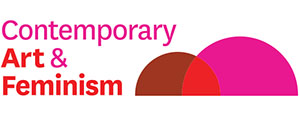24 October to 8 November 2015
Curated by Barbara Halnan
Articulate Project Space
497 Parramatta Road, Leichhardt, Sydney
William Seeto
Published courtesy of Rochford Street Review, Issue 16, 27 October 2015

‘Inside-Out Sculpture’ 2015. Photo by William Seeto
“The gallery space: Rarified atmosphere – pristine environment where experiments can take place with the least amount of interference from variables, which may or may not influence the experiment.”
Rose McGreevy
By engaging with the all-white gallery space, Rose Ann McGreevy believes she did not look at spatiality in a literal sense, as a diagram or visual metaphor that explores and confronts rupture and straddles culture but as a personal codex that offers formalised dialogue.(1) ‘Site’ and ‘art’ are queried on whether one or the other is more important and did they interact, inform or interfere with the work. Two new sculptural works are included in the survey of McGreevy’s work and I concentrate mainly on these as they form the core of the exhibition. The first is Inside-Out Sculpture, a long structure consisting of two walls in close proximity and the second is The man who rolled a stone up a hill, a pair of motorised boots slightly smaller than life size. In creating Inside-Out Sculpture, a mediated constructed installation made in the absence of the artist, issues of collaboration and authorship are highlighted.
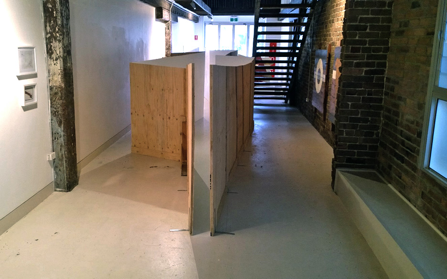
‘Inside-Out Sculpture’ 2015. Photo by William Seeto
Inside-Out Sculpture (2) is a work that engages with sculpture and the constructed environment by merging both in the space in between. The sculpture is a long structure made of two walls in close proximity, 10 metres in length, 2.7 metres at its widest and 1.8 metres high – the building’s dimensions are considered in determining its size, shape, location and spatiality. It consists of a sculpture with external and internal form with narrow openings at both ends, which prevent entry into the clean white space within that replicates the finish of the all-white gallery. Audience movement is constricted in the tight space, as they are only allowed to walk around the work in narrow aisles and peer over walls high enough to stop entry but low enough to look over. The external appearance is left unfinished and provides visual and tactile contrast to the highly finished white interior. The long narrow configuration of the building as well as the work situated within prevents observers from seeing the entire work at a glance from one vantage point and multiple views from different areas are needed to take-in the work.
In determining meaning, the work contradicts the artist’s belief it did not constitute a diagram or visual metaphor that confronts rupture and straddles culture, however the inclusion of a personal codex suggests it does not follow a Minimalist trend although it is minimal and abstract in appearance. Ideas and emotions saturate the work through visual metaphor for feelings of loss, alienation and precarious security embodied by emotional and psychological space. This is referenced in her notes on another work where McGreevy writes ‘I put marks on the wall in an attempt to place in the gallery/ public space ideas and emotions that are not easily grabbed or quantified in the concrete world’. In assessing the work, this contradiction requires knowing more about her life. The major part of McGreevy’s upbringing takes place in Belfast, Northern Ireland along with ‘the troubles’ and family-related issues that have profound effects on her personally, which creates a contradictory, complex, and private person in later life. In making sense out of it all, her past experiences are excoriated, examined and externalised in her work.
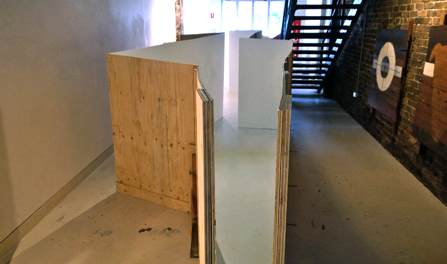
‘Inside-Out Sculpture’ 2015. Photo by William Seeto
Inside-Out Sculpture hints at being on one side or the other, fitting-in or not fitting-in. The major component is the wall, which in most cases is used to delineate boundaries or to keep others out and those inside safe; the psychological feeling of safeness is a recurring theme in her work, no doubt a result of experiences related to religious sectarianism, personal issues, and art world cliques. Whilst living in Northern Ireland, she was a founding member and director of Art and Research Exchange in Belfast, a meeting place to bring together both sides of conflict that was funded by Joseph Beuys. The wall defines the space by occupying most of it and observers cannot enter the internal space of the work. They are situated as outsiders who can only look into the forbidden place, a recurring theme for Catholics, and a perceived division in the art world for the anointed and those who are not. Inside-Out Sculpture speaks more about exclusion than safety, as one of the things McGreevy found annoying in the art world was the inclusion and exclusion of artists by galleries and museums. The work transfers McGreevy’s feelings of the ‘outsider’ to the viewer and brings them a step closer to her thoughts. A result of social interaction is the projection of a public persona relative to a private one that is often concealed, and the artwork inverts and makes the private public. Here, the observer’s gaze is replaced by participatory engagement; by creating a long wall that is low enough to peer over, McGreevy compels viewers to look and interact with it, close-up at eye level, in your face. However, one’s desire to enter is denied and instead of looking from a distance, the observer is absorbed by the work – it requires a closeness not associated with or encouraged when viewing artworks, as it incorporates private and public, form and concept, signifier and signified. It embodies feelings of loss, alienation and precarious security also found in the accompanying work in the exhibition.
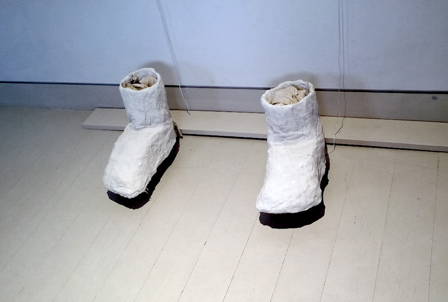
‘The man who rolled a stone up a hill’ 2015. Photo by William Seeto
The man who rolled a stone up a hill (3) consists of a pair of fabricated white boots in repetitive motion that slowly traverses a prescribed distance, returns and starts all over again; it offers a metaphor on life made meaningless by enlisting technology for its movement and a likeness to the human condition in its behaviour, which is predetermined in a way that sets the scene for activity, beauty and desire. McGreevy examines repetition as absurd occupation, which according to author Albert Camus’ interpretation of The Myth of Sisyphus introduces us to his philosophy of the absurd: Man’s futile search for meaning, unity, and clarity. It compares the absurdity of life with Sisyphus’ situation, a figure in mythology who defies the gods and is condemned to repeat the same meaningless task of pushing a boulder up a mountain, only to see it roll down again. The man who rolled a stone up a hill presents the disembodied extremity of an absent torso in the form of boots. The human body is implied but we see no figure, only a ghostly state presented by incorporeal boots in perpetual repetitive motion. The title appears at odds with the work until we note its reference to Sisyphus; movement co-opts abstract metaphoric form to ask, is there beauty in ongoing slow, deliberate movement.
The concept of motion in sculpture is not new as investigations in the 1970s by art theorist Jack Burnham seeks new theoretical ground for sculpture and finds cybernetics a source for new ideas. He highlights sculpture’s move from object to systems art, sophistication in specialised skills, a technology gap in production, and the artist as part of a technological elite.(4) Burnham predicts a transition from biological to mechanical/ inorganic evolution taking place, as forecast by Roger MacGowan and Frederick Ordway who contend a mechanical/ inorganic evolution is unavoidable after an extended period of biological evolution, which eventually dominates its maker and the only solution is to dumb-down intelligence in automata.(5) McGreevy’s interest in technology is presented by a sculpture modest in its use of technology as interface, an inflexion where sophistication is ‘dumb-downed’. Technology is not a major concern for McGreevy, as the desire is to extend her artistic vocabulary and use it for making autonomous sculpture, which in McGreevy’s words ‘performs a repetitive function that refers to the nature of machines and human desires to have them imitate us. The work questions the conundrum of desire, activity and beauty’.
Spatial abstraction, perception and metaphor
In deciphering the work, there is a need to refer to sculpture’s spatial development in the twentieth-century that combines sculptural form and architectural space with artworks that deconstruct, subvert and transform architecture. In the 1970s, sculptor Carl André defined sculpture as form, structure and place. That is, sculpture was looked at in three stages of development: As external form, interior structure, and situated place. In my view there is an additional stage incorporating structure and place within architecture – a combined unitary form on the architectural site that refers to the conceptual broadening of and development of an additional referent to André’s concept. It merges ‘structure and place’ as a result of considering the environment of the work’s location. For André, place is associated with entering a defined area, movement in and around the work and the viewers’ experience facilitated by walking through the space.
The main component of Inside-Out Sculpture is its location, horizontality and stability, presentation of internal and external, and material weight in bonding the structure together. It incorporates ‘structure and place’ within the space of the gallery, a considered idea compelling observers to move in predetermined pathways around the structure, which engage viewers in walking around, looking at and into the work. The sculptural installation uses space based on the kinaesthetic perception of space and movement emphasising elements of time, experience and mental space, which have affinities with the spatial theories of sculptor and art theorist Robert Morris.
Robert Morris defines the concept of spatiality as paradigms of time, experience and mental space. For Morris, ‘time’ became important in understanding work and duration distinguishes thought; perception of space became more about the body moving around in the environment, and kinaesthetic experience incorporates time in the work. There is a shift in ‘experience’, which is embedded in the nature of perception, a circumstance where experience of work is prioritised and takes the place of viewing from fixed positions; as new information is acquired our perceptions change. The ‘mental space’ of Morris incorporates a relationship between memory and immediate experience, and states of consciousness other than the immediate present experienced as memory, reflection, imagining and fantasy. For Morris, mental space is when one imagines being in another place or time in the midst of present activity. It did not exist as real space because it has no physical dimension or location. In describing mental space, Morris alludes to mental space as metaphor for the space of the world. There is a shift towards the recall of spatial experience and focus from the exterior environment to the self.
The perception of space, movement, time, duration, memory and reflection also takes form in McGreevy’s work. Although it is not known if she had knowledge of the spatial theories of Morris and André, she would have known about their work, which is in an area her own work delves that is related to notions of visual metaphor incorporating conscious states other than the immediate present – Morris’ mental space. The personal codex offering dialogue appears in Inside-Out Sculpture and The man who rolled a stone up a hill along with other works defined by subject matter, use of text and considered titles. An integral part of her practice translates abstract concepts into form through text, where language is woven into the work. As an example, for an installation titled ‘Intimacy’ at Articulate Project Space in 2010, McGreevy describes how words are used to play with open-ended blank verse, verse without structural lines and rhythm. The work references sculpture, painting, mark making, two and three-dimensional art, and implicates the wall and alcove with text and suspended paint-filled plastic tubes. Her use of commercially available material as media reminds one of American sculptor Bill Bollinger, a relatively unknown but important American artist known for his minimalist sculptures and use of readily available hardware.
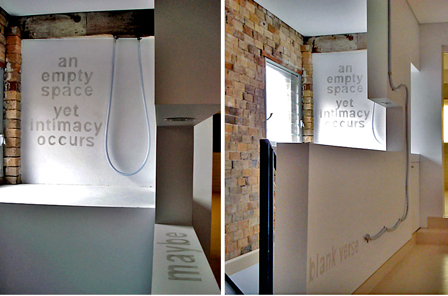
‘Intimacy ‘ 2010 at Articulate Project Space, Sydney. Photo by William Seeto
In another work, a text and sound exhibition titled ‘The transience of soap’ in 2001 at The Tin Sheds Gallery, McGreevy collaborates with Barbara Halnan and Warren Summers to create ephemeral spatial drawings using suspended perspex etched with text, where the passage of time is an essential part of the work. The exhibition opens with a performance by instrumentalists and vocalists in response to the contours of the gallery walls and hanging panels that act as cues for vocal improvisation. A recurring motif is the boot, which also appears in other exhibitions as static object, a precursor for The man who rolled a stone up a hill.
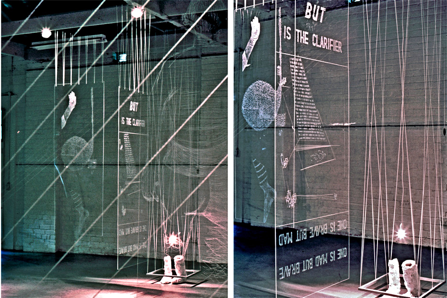
‘The transience of soap’ at The Tin Sheds Gallery, Sydney. 2001
The coherence of incoherence (6)
The last works of Rose Ann McGreevy have no plans or instructions for construction and the enormous difficulty encountered in making Inside-Out Sculpture using just the exhibition proposal and drawing highlights the issue of collaboration, the intermediary, authorship and attribution.
Inside-Out Sculpture requires a versatile adaptive imagination in realising McGreevy’s vision and the danger of introducing new elements is ever present. In the artist’s absence an unintended outcome results in adjustments that are uncharacteristic of her usual understated approach. A denouement is visited in our understanding that in the artist’s absence the intermediary completes the work; collaborations differ as decisions are made together but the situation here is uniquely different. The waters are further muddied when artist and collaborator have mutual history in working together.
My conclusion about the making of Inside-Out Sculpture places it as a mediated collaborative effort by artist and collaborator rather than an individual’s work. This is because it is facilitated by the primary artist’s initial concept design, and the secondary artist’s practical design, construction and placement. The question posed is whether adjustments added to the concept design and made it a variation on the original.

‘Inside-Out Sculpture’ 2015. Artwork design by Barbara Halnan
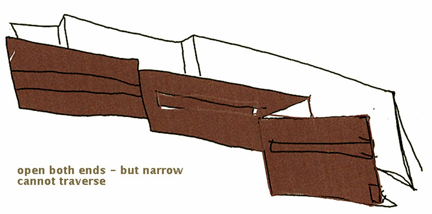
‘Inside-Out Sculpture’ 2014. Artwork design by Rose McGreevy
“The inside-out sculpture – working title.
Around 30 feet long, 2 feet wide, and 5 feet high.
Work to be constructed in gallery from wood, metal and perhaps plastic tubing. Inspiration taken from Pompidou Centre, Art Gallery in Paris, France whose ‘working’ bits are mostly on the outside – not hidden – a transparent architecture. How something is made is fascinating to me and to have that articulation seen is paramount to this sculpture. Inside will be white, sheer and clean lines and the exterior will have all the marks and mechanisms of its construction. The inside will bring to mind the unmitigated perfect white walls of a gallery. It will be tall enough so that the viewer will have to peek in and therefore made aware that they are looking into the sculpture as opposed to looking at it – a transparent sculpture which cannot be seen through but looked into as one might a crevice and yet like all sculpture it will envelope, employ, contain and define space.” (Exhibition proposal)
Rose McGreevy

Rose Ann McGreevy. Bounds Green, London. ca. 1990s
Biographical note
Rose Ann McGreevy was born in Belfast in 1945, adopted and raised in a Catholic family, and resided in Sydney later in life. She lived and worked in Belfast and London from 1972 to 1990 before migrating permanently to Australia in 1990. She is known for her work in sculpture, site-specific installation, text, drawing, video, film, and digital media. She was a founding member and director of Art and Research Exchange in Belfast – an initiative funded by Joseph Beuys, and a founding member of the Irish Women Artists Group in London.
She studied Visual Art at Belfast Art College – Ulster Polytechnic (Foundation Course), Ulster University (B.A. Hons), and Chelsea School of Art (M.A.).
She lectured part and full-time at Chelsea School of Art, Middlesex Polytechnic, Royal College of Art, University of Ulster, Royal Academy of the Arts, Limerick College of the Arts, various regional Art Colleges, Universities and Polytechnics in the UK; and in Sydney at Sydney College of the Arts – University of Sydney, and College of Fine Arts – University of NSW.
She exhibited in London at Chisenhale Gallery, Irish Centre Gallery, Brixton Art Gallery, Featherstone Street Gallery, Small Mansions Gallery, Sisterwrite Bookshop/ Gallery; in Belfast at Art and Research Exchange Gallery, Crescent Arts Centre Gallery; and Grapevine Gallery Dublin; in Australia at the Institute of Modern Art Brisbane, Level 17 Victoria University Melbourne, and in Sydney at First Draft West, Art Unit, James Harvey Gallery, The Performance Space, Pendulum Gallery, Selenium Gallery, Crissie Cotter Gallery, Sir Hermann Black Gallery, The Tin Sheds Gallery, Factory 49, and Articulate Project Space.
Author’s note
In looking at the last works of Rose Ann McGreevy, my considered thought is she was on the cusp of a new body of large sculptural site-specific works. This would place her amongst exceptional artists who conceptualise artworks that are minimal, spatial and combine minimalist presentation with metaphoric meaning. She understood about the space in between sculpture and architecture. Contrary to her belief the work was not a diagram or visual metaphor that explores and confronts rupture and straddles culture, these metaphoric elements are present when delving into her work and personal history.
Rose’s artistic life before migrating to Australia hides the fact she was an accomplished artist in Belfast and London before moving to Sydney. Like most who migrate to other countries, it meant starting from scratch and our perception of her was without reference to the past. My initial encounter with Rose began in the early 1980s at Sydney College of the Arts when she was a visiting resident international artist and I was in my graduate diploma year. I still have fond memories of afternoons spent at Dick’s Hotel in Balmain enjoying a drink and talks about art. Sydney College was the place where most of us first met Rose at a time when the Sydney art scene was undergoing changes that introduced new ideas in art, text, and semiotics. Like other exceptional artists she was not one who talked about her achievements, however we knew she was a person of substance by what she said and made of her life. For all who knew her she left an indelible impression with her wit and humour that masked her professionalism as an artist and dedication as an academic.
The solo exhibition of Rose’s work at Articulate Project Space was to have taken place in March 2015 with the provisional title of Inside-Out Sculpture but it was deferred to October 2015 due to Rose’s illness and death on 20 October 2014. During the process, the exhibition of new work became a large survey show that includes older work, as well as documentation of her process and thoughts. Rose’s artistic and academic achievements were unrecognised in her lifetime and in order to remedy the situation Articulate Project Space initiated talks with her in 2014 about the exhibition – ‘Rose McGreevy 1945-2014’ resulted from the work of the many who had a hand in its realisation.
I have been privileged to known Rose, on and off, for over thirty years and I look upon the exhibition not only from a personal viewpoint but also from a professional one that is informed by many years of experience in site-specific constructed installation. As with most who knew her, I am pleased to see an exhibition that celebrates a much-respected friend and dedicated artist.
– William Seeto
William Seeto is a practicing installation artist and independent curator with a practice of 34 years. His site-specific constructed installations investigate non-objective abstraction and perceptual qualities in constructed environments that reconstructs architectural space in a blend of minimalism, process art and kinaesthetic experience that incorporates immersive light, sensory perception and luminal effects of uniform light (Ganzfelds).
He studied Visual Art at Sydney College of the Arts – University of Sydney (Ph.D, Grad.Dip, B.A.Deg), and Gallery Management at the College of Fine Arts – University of NSW (Grad.Dip).
Endnotes
- Sourced from Rose McGreevy’s notebook.
- Rose McGreevy’s long-time friend and fellow artist Barbara Halnan designed and constructed Inside-Out Sculpture from Rose’s notes and drawings.
- Artist Paul Cooper designed and constructed The man who rolled a stone up a hill from Rose McGreevy’s notes and drawings.
- Jack Burnham, ‘Beyond Modern Sculpture: The Effects of Science and Technology on the Sculpture of this Century’ (1968).
- Roger MacGowan and Frederick Ordway, ‘Intelligence in the Universe’ (1966).
- The subtitle ‘The coherence of incoherence’ is a quote from Rose McGreevy’s notebook.
This project is supported by Leichhardt Council, Sydney

